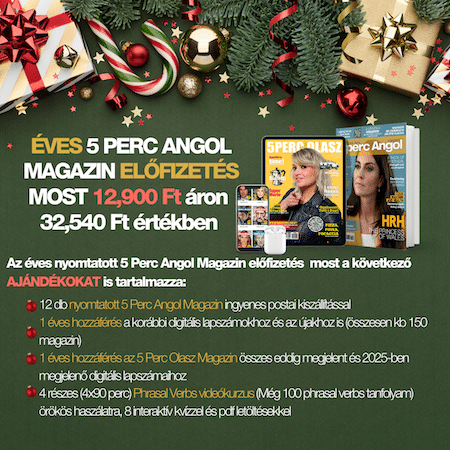Szia,
Ma tovább folytatjuk a karácsonyozást, és megnézzük, hol, hogyan szokták ünnepelni a karácsonyt.
A karácsonyi ajándékokkal kapcsolatban is van egy tippem számodra: használd az 50% engedményt adó kuponkódot, amely érvényes szinte minden videókurzusra (örökös hozzáféréssel), ráadásul számos könyv és kártya is kedvezménnyel kapható most.

KUPONKÓD: christmas2024
Ezt kell vásárlás végén begépelned, hogy az 50% kedvezményt érvényesíteni tudd! Remélem találsz valami kedvedre valót!
A nyomtatott magazinra pedig most nagyon megéri előfizetni, hiszen a már megszokott digitális előfizetés ajándék (+ hozzáférés 2012-ig minden lapszám digitális verziójához) mellé egy Phrasal Verbs videókurzust is kapsz (“Még 100 phrasal verbs”) SŐT az 5 Perc Olasz Magazinhoz is kapsz egy éves digitális előfizetést (+ hozzáférsz minden korábbi lapszámhoz digitálisan) – a fiókot a www.5percolasz.hu oldalon kell ehhez létrehoznod.

Most pedig nézzük a leckét!
Üdv,
Nóri
MAI LECKE
Celebrating Christmas
a hanganyagot itt éred el: HANGANYAG
Christmas, which is celebrated on December 25, is one of the biggest celebrations of the year in many countries around the world. Christmas is a very important day for the members of the Christian religion because it commemorates the birth of Jesus Christ. At church services around the world, people retell the story of the birth of Jesus in the manger in Bethlehem. In many countries the Christmas season actually lasts for almost a moth. Streets, squares, homes and shopsare decorated and illuminated everywhere.
Many of the traditional Christmas customs originate in pagan festivals. Thousands of years ago people were often afraid of the long, cold winter nights. When the days finally became longer, people celebrated the return of the sun by making bonfires, feasting on large meals and exchanging gifts. After the birth of Christ, many of these traditions were combined with the celebration of Christmas.
The word Christmas, itself, comes from the Old English name ‘Cristes Maesse’. The first recorded observance occurred in Rome in AD360, but it wasn’t until AD440 that the Christian Church fixed a celebration date of 25 December.
Christmas in Britain
Most people are on holiday in the UK and stay at home with their families on Christmas day, the main day for Christmas celebrations in Britain, when the family members gather to have a Christmas dinner at midday. During the weeks before Christmas, people send cards and go to Carol services and put up Christmas decorations in their homes. There is one very British Christmas ritual, which is watching the Queen’s message on TV. The tradition began in 1932 when King George V read a special speech written by Rudyard Kipling. The broadcast was an enormous success. Queen Elizabeth II continues the tradition to this day. Every year she broadcasts her message on Christmas Day, and it is heard by millions of people all over the world. In England most people watch or listen to it after their Christmas Dinner!
Pulling a Christmas cracker is also a popular British tradition. But what is a Christmas cracker? Christmas crackers are tubes made of brightly coloured paper. When pulled apart, it makes a pop sound. Crackers usually contain a small gift, a paper hat and a joke. Crackers are famous for their very bad jokes! The party hats look like crowns, similar to the ones worn by the Wise Men. There is normally a cracker next to each plate on the Christmas dinner table.
Christmas in the United States
Just like in the UK, Christmas in the USA is observed on the 25th of December. Here the festive season begins on the fourth Thursday in November, just after the Thanksgiving holiday. Christmas Eve in the USA is not an official holiday, which means that most people have to work. However, many workplaces hold Christmas parties and celebrations. After dinner on Christmas Eve, children go to bed early but not before hanging up their stockings on the fireplace or the end of their bed to be filled with gifts by Santa Claus. On the following morning, children wake up to look for their presents in their stockings and under the Christmas tree.
Boxing Day
Boxing Day is a public holiday in the United Kingdom, Canada, New Zealand and Australia. It is also a holiday in many other countries in the Commonwealth of Nations. It is based on a long custom of giving gifts to poor people. It is usually celebrated on 26 December, the day after Christmas Day. In some countries the public holiday is moved to the next weekday if 26 December is a Saturday or Sunday. Boxing Day is an old custom going back to the Middle Ages.
Christmas in Hungary
In Hungary the Christmas tree is decorated on Christmas Eve. In addition to the usual decorations, Hungarians also put fondant candies on and under the tree. According to the Hungarian tradition, the Christmas presents are brought by baby Jesus, although some families (who belong to other religions or atheists) follow the Santa Claus tradition, which was promoted also by the communist government that ruled until 1990. Typical Hungarian Christmas dishes include: fish soup or bouillon, stuffed cabbage, roast turkey with stuffing, and the famous poppy seed or walnut rolls, which is a traditional Hungarian pastry, mostly eaten during the winter holidays. It is basically a kind of sweet bread, known as ‘beigli’ in Hungary. During the last few decades other variants (such as chestnut, plum jam, prune, or even cocoa) have become popular, too.
to be celebrated[tə bi ˈselɪbreɪtɪd] – megünnepelve lenni
celebration [ˌselɪˈbreɪʃən] – ünnepség
Christian religion [ˈkrɪstʃən rɪˈlɪdʒən] – keresztény vallás
to commemorate [tə kəˈmeməreɪt] – megemlékezni
church service [tʃɜːtʃ ˈsɜːvɪs] – templomi szertartás
to retell [tə ˌriːˈtel] – újramesélni
manger [ˈmeɪndʒə] – jászol
to last [tə lɑːst] – időben tartani valameddig
to be decorated [tə bi ˈdekəreɪtɪd] – kidíszítve lenni
to be illuminated [tə bi ɪˈluːmɪneɪtɪd] – kivilágítva lenni
traditional [trəˈdɪʃənəl] – hagyományos
custom [ˈkʌstəm] – szokás
to originate in [tu əˈrɪdʒɪneɪt ɪn] – valahonnan ered valahonnan
pagan festival [ˈpeɪɡən ˈfestɪvəl] – pogány ünnepség
to be afraid of [tə bi əˈfreɪd ɒv] – félni valamitől
bonfire [ˈbɒnfaɪə] – örömtűz, máglya
to feast on [tə fiːst ɒn] belakmározni valamiből
to be combined with [tə bi kəmˈbaɪnd wɪð] – valamivel vegyítve lenni
recorded observance [rɪˈkɔːdɪd əbˈzɜːvəns] – feljegyzett szertartás/ ünnepség
to occur [tu əˈkɜː] – megtörténni, történni
main [meɪn] – fő- , legfőbb
to gather [tə ˈɡæðə] – összegyűlni
ritual [ˈrɪtʃʊəl] – rituálé
broadcast [ˈbrɔːdkɑːst] – közvetítés
enormous [ɪˈnɔːməs] – hatalmas
success [səkˈses] – siker
tube [tjuːb] – tubus, cső
brightly coloured [ˈbraɪtli ˈkʌləd] – fényesen színes
to pull apart [tə pʊl əˈpɑːt] – széthúzni
to be observed [tə bi əbˈzɜːvd] – megünnepelve/megtartva lenni
Thanksgiving [θænksˈɡɪvɪŋ] – Hálaadás
official [əˈfɪʃəl] – hivatalos
workplace [ˈwɜːkpleɪs] – munkahely
stocking [ˈstɒkɪŋ] – zokni, harisnya
fireplace [ˈfaɪəpleɪs] – kandalló
public holiday [ˈpʌblɪk ˈhɒlədeɪ] – nemzeti ünnep
to be based on [tə bi beɪst ɒn] – valamin alapulni
Middle Ages [ˈmɪdəl ˈeɪdʒɪz] – középkor
in addition to [ɪn əˈdɪʃən tuː] – … felett, …-on/-en-/-ön felül
fondant candy [ˈfɒndənt ˈkændi] – szaloncukor
according to [əˈkɔːdɪŋ tuː] – szerint
to belong to [tə bɪˈlɒŋ tuː] – tartozni valamihez
to be promoted [tə bi prəˈməʊtɪd] – elősegíteni, reklámozni
bouillon [ˈbuːjɒn] – húsleves
stuffed cabbage [stʌft ˈkæbɪdʒ] – töltött káposzta
stuffing [ˈstʌfɪŋ] – töltelék
pastry [ˈpeɪstri] – sütemény
decade [ˈdekeɪd] – évtized
variant [ˈveərɪənt] – variáns
chestnut [ˈtʃesnʌt] – gesztenye
prune [pruːn] – aszalt szilva



